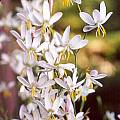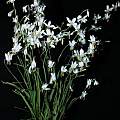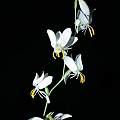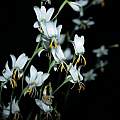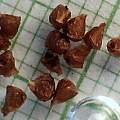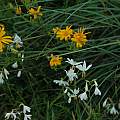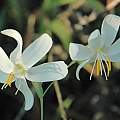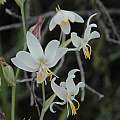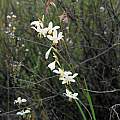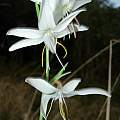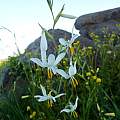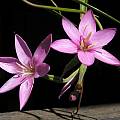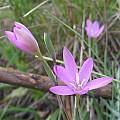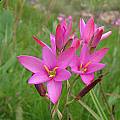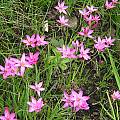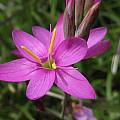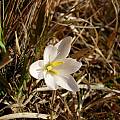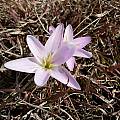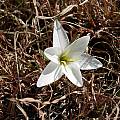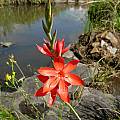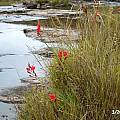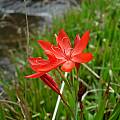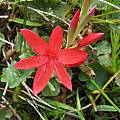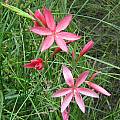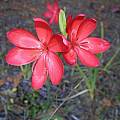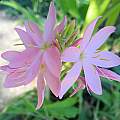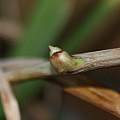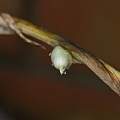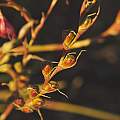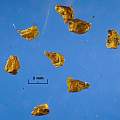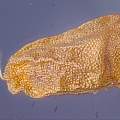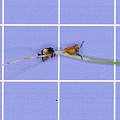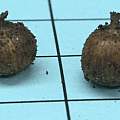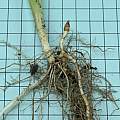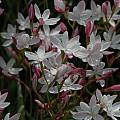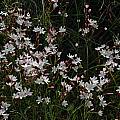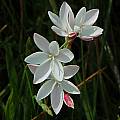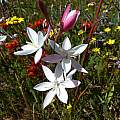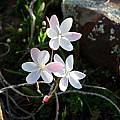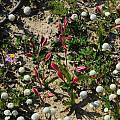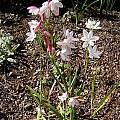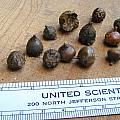Hesperantha is a cormous genus in the Iridaceae family from southern and tropical Africa. Species a-c are found on this wiki page. See the links below for information about this genus and other species.
Hesperantha species d-j – Hesperantha species l-p – Hesperantha species q-z – Hesperantha index
Hesperantha bachmannii Baker is widespread from Namaqualand to the Eastern Cape where it grows on clay slopes in renosterveld, in dry bush, or along streams. It therefore grows both in winter and summer rainfall areas. This species has very nicely fragrant white flowers facing to one side, nodding with petals curled back. Flowers open late afternoon or early evening. Height: 15-30 cm. This species blooms late winter into spring and is pollinated by moths. Sometimes the older flowers take on a pinkish color. Photo 1 from Mary Sue Ittner shows plants grown from seed and blooming in Northern California. Photos 2-4 were taken by Nhu Nguyen. Photo 5 by M. Gastil-Buhl shows seed from PBS BX 317 #22 on a 1 mm grid.
The photos below were taken in the wild. Photos number one and two were taken in Namaqualand and number three and four on the Bokkeveld Plateau near Nieuwoudtville by Mary Sue Ittner and Bob Rutemoeller.
Photos below were taken by Cameron McMaster near Bedford in the Eastern Cape, near Biedouw, and near Nieuwoudtville.
Hesperantha baurii Baker is a summer rainfall species from the Drakensberg Mountains, KwaZulu-Natal, Lesotho, and the Transvaal. It has rose or mauve star-like flowers that open during the day. It is pollinated both by beetles and bees. As a high elevation species it would be hardier than some of the Cape species. Height: 15-30 cm. The first photo by Bob Rutemoeller was taken of one grown in Northern California. The rest of the photos from Cameron McMaster show plants in the wild. The first photo was taken in the Mafika-Lisiu Pass, Lesotho, and the others were taken at Sentinel Peak in the Drakensberg.
Hesperantha candida Baker flowers in late winter, early spring before the summer rains in a wide distribution in summer rainfall South Africa where it grows in grassland and often stony sites. It is short, about 4-15 cm high, with 1 to 6 salver-shaped pale pink, lilac or white flowers flushed brown to greenish purple on the reverse. Photos by Cameron McMaster were taken in the Eastern Cape.
Hesperantha coccinea (Backh. & Harv.) Goldblatt & J.C.Manning previously and still sometimes referred to as Schizostylis coccinea Backh. & Harv. grows from a rhizome instead of a corm. This species was the subject of the pbs list topic of the week in February 2003. The topic: Schizostylis - Hesperantha, a confused genus was introduced by Alan Kennedy who has a NCCPG National Collection of Schizostylis Cultivars and was finding it hard to tell them apart. Click on this link to read his Introduction.
It is known locally as the Scarlet River Lily because it is confined to perennial stream banks and islands in the high altitude regions of the Eastern Cape and Natal at altitudes of 1500 to 2500 m. It is never found away from water and the plants are permanently in a wet or at least moist environment with the stream often running over and through them. The red form of this species is pollinated by butterflies. This species has a specific flowering time in the Southern Hemisphere, autumn, March and April with maybe a few flowers in late February. We have found plants to grow readily in gardens in South Africa provided they are kept moist. They are good subjects to place around garden pools or in wet areas of the garden and multiply rapidly. This species also grows very easily from seed. Height range: 1-2 ft. Photos from Cameron McMaster shown in habitat in the Eastern Cape including Rockford Bridge, Cathcart, Stutterheim, and Andriesberg. This species is found both in tropical Africa and in eastern South Africa.
In my Northern California garden this plant is invasive with regular summer water and with little summer water often disappears. The first photo below taken by Bob Rutemoeller shows one of the cultivars available for purchase blooming in September 2003 that we thought had disappeared. Since then it has died. The second photo taken by Harmony Susalla is a pink form that is growing in many places and blooming October 2009 in a garden that gets watered in summer in Northern California.
Photos by David Pilling illustrate two different ways this species can increase. The first two show that corm like propagules are produced on the stems around swollen points (aerial axils) at the end of the season. These can be used to produce new plants but may take a year or two to start growing. The next photograph shows ripening seed pods and was taken on the promenade at Grange over Sands, 1st December 2012. Photo 4 is of seed; what you see is a skin which can be removed from the seed. Photo 5 is a magnified view. Photo 6 shows a seed germinating after three weeks of being exposed to moisture at around 65 °F (grid spacing 10 mm).
Going underground in late November 2021, when the plants were not dormant. The first photo shows little corms that were to be found; the second shows roots on a 1 cm grid.
Hesperantha cucullata Klatt is found on sandy and shale slopes in the western Karoo and the northwest Cape from the Bokkeveld Plateau to the Biedouw valley. It has three to eight white flowers on a spike and flowers open in late afternoon or evening and are often fragrant (jasmine or frangipani) during the night. The outer tepals have a brown or red reverse so during the day you may only see the bright colored buds, but if out exploring later in the day the flowers will have opened. Height range: 15-30 cm tall. It is pollinated both by bees and moths. Photos 1-4 by Bob Rutemoeller and Mary Sue Ittner of plants blooming near Nieuwoudtville in September 2006. Photo 5 was taken by Cameron McMaster in the Nieuwoudtville reserve September 2011.
Photos taken by Cameron McMaster and Mary Sue Ittner in the Roggeveld. The last two show how this plant looks during the day when the flowers have yet to open.
Photographs by Mary Sue Ittner of one grown from seed that shows the leaves and another of the corms that are rounded with an oblique side.
Hesperantha species d-j – Hesperantha species l-p – Hesperantha species q-z – Hesperantha index
